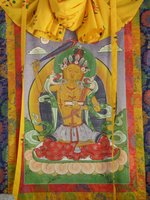Taking Buddhism to the Himalayas?
 Munisha reports from Bhutan...
Munisha reports from Bhutan...Last August I spent a very interesting three weeks in Bhutan. As the education officer at The Clear Vision Trust, I'd been asked by the Bhutanese Ministry of Education to come and put the finishing touches to their draft Framework for Values Education - which overlaps with the curriculum areas known in the UK as Religious Education, Social, Moral, Spiritual and Cultural Education, and Citizenship Education. I asked Joyce Miller to accompany me; she's a Theravadin laywoman and recently retired Bradford (UK) Local Education Authority officer for Diversity and Social Cohesion.
 Bhutan straddles the eastern Himalaya. It's about the size of Switzerland, with a population of 600,000 mostly subsistence farmers, mostly Buddhists. Sandwiched between two superpowers, China and India, its survival as a sovereign nation relies on the maintenance of its distinctive culture, traditions and landscape, whilst meeting modern, global culture. Bhutanese are among the millions who have jumped straight from no phone to mobile phone; from almost no TV to cable. They're also moving from 100 years of absolute monarchy to a constitutional monarchy: March 2008 sees Bhutan's first elections.
Bhutan straddles the eastern Himalaya. It's about the size of Switzerland, with a population of 600,000 mostly subsistence farmers, mostly Buddhists. Sandwiched between two superpowers, China and India, its survival as a sovereign nation relies on the maintenance of its distinctive culture, traditions and landscape, whilst meeting modern, global culture. Bhutanese are among the millions who have jumped straight from no phone to mobile phone; from almost no TV to cable. They're also moving from 100 years of absolute monarchy to a constitutional monarchy: March 2008 sees Bhutan's first elections.Perhaps the most valuable thing Bhutan has given the world is the concept of Gross National Happiness (GNH): the notion that the true wealth of a nation is to be measured not by its industrial and commercial output but by the all-round wellbeing of its people. All public policy is formed with GNH in mind, and education is part of this.
Our visit began with a presentation demonstrating our understanding of Values Education, and something of Bhutan's present spiritual and political culture. With the vice chancellor of the new university as Chair the officials sat in rank order down a long table. All in national dress, as he entered they bowed in turn, stroking the backs of their fingers across the floor towards their feet. During the discussion following our presentation, we noticed they contributed also in rank order. They'd specifically requested a PowerPoint presentation, which unfortunately became a PowerCut presentation. I won't forget their insistence on hearing some of the new Clear Vision CD of meditations for young people: the entire room in silence, most of them probably meditating for the first time, led by the voice of a female western Buddhist - me!
 After that there were four fascinating days of visits to schools and teacher trainers, assessing the current teaching of Values. And further meetings, and work on the Framework - except that they kept taking us out sightseeing in office hours, so that eventually there were just four days for our work on knocking the Framework into shape, drawing up tables of exactly what values could be taught through what themes and activities, across all the years of school; all without explicitly mentioning Buddhism. The school system is secular (even if every day begins with lengthy whole-school prayers to Jampelyang, God of Wisdom - aka Manjushri - see photo) and up to 20% of Bhutanese are Hindu.
After that there were four fascinating days of visits to schools and teacher trainers, assessing the current teaching of Values. And further meetings, and work on the Framework - except that they kept taking us out sightseeing in office hours, so that eventually there were just four days for our work on knocking the Framework into shape, drawing up tables of exactly what values could be taught through what themes and activities, across all the years of school; all without explicitly mentioning Buddhism. The school system is secular (even if every day begins with lengthy whole-school prayers to Jampelyang, God of Wisdom - aka Manjushri - see photo) and up to 20% of Bhutanese are Hindu.So, why did the government of a more than thousand year-old Buddhist culture consult a pair of British convert Buddhists? The Bhutanese educationalists we met love the Dharma and are exasperated at the lack of Dharma teaching for laypeople. Many of these educationalists are highly educated at western universities; one said he had learned all his Dharma from an Eastern Religions course at a Canadian university. Many are reading western Dharma books. We heard of school teachers sent abroad on Goenka retreats, much to the annoyance of Bhutanese monastics. “Well!”, commented the vice-chancellor - "What are THEY doing?"
I saw in senior educationalists a desire to introduce young people to what I'd call a “useable Buddhism”. Most Bhutanese lay Buddhists never learn to meditate or study even basic teachings, because Himalayan Buddhism is esoteric and traditionally the preserve of monastics, whom laypeople support out of a respect for tradition. But across Asia (and among British Asian Buddhists) many young people are no longer inspired by tradition. They want to be modern, western. If they become interested in Buddhism, it will be because someone teaches it from scratch, as we would do in the Religious Education classroom, with teaching materials such as Clear Vision's, and they find it makes sense.
Our hosts were keen to invite us back to train the country's headteachers in the new syllabus, which is planned to start in January 2009. However, the elections mean that the country's tiny civil service is entirely preoccupied with voter education. Add to this the coronation of the new king in May and I doubt we'll be hearing from them for some time!
Labels: Bhutan, Clear Vision, Education

 rss
rss